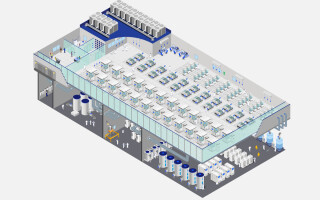Transform the factory with the Internet of Things Performance, graphics, and security with 4th generation Intel Core processor
August 01, 2013
The 4th generation Intel Core processor family is bringing the Internet of Things to the factory floor. With 2x faster signal processing, the processo...
Throughout history, new technologies have transformed the manufacturing industry. From the invention of steam engines to the introduction of computerized controls, these technologies have led to enormous leaps in productivity and quality. Today we are at another turning point. The introduction of intelligent systems and Internet of Things technology are enabling unprecedented data sharing and analysis, turning previously disconnected manufacturing systems into an efficient, highly responsive whole.
The following describes how Intel is enabling the transformation with its 4th generation Intel Core processor family based on the Haswell microarchitecture. Boasting up to 15 percent higher performance, 2x faster image and signal processing, up to 60 percent faster graphics, newly flexible high-speed I/O, and enhanced security, this platform offers major upgrades over its predecessors. As we will see, the new processors deliver scalable, robust performance for applications ranging from machine vision to machine diagnosis, from building controls to operator panels, and even top floor administrative servers (Figure 1). In addition, the platform’s new security and manageability features make it well suited for the highly connected, Internet of Things-enabled factories of the future.
Along the way we’ll present examples where members of the Intel Intelligent Systems Alliance are taking advantage of the new processors.
Improved performance
Performance is critical in Internet of Things-enabled factories, as it enables greater analysis of product quality, equipment performance, and other factors. Overall performance is up 15 percent in the new processors, while signal and image processing get an additional 2x boost with Intel Advanced Vector Extensions (Intel AVX) 2.0. As shown in Table 1, Intel AVX 2.0 introduces a fully pipelined Fused Multiply Add (FMA3) that provides twice the floating-point performance of the previous generation for the multiply-add workloads common in image processing. Intel AVX 2.0 also extends integer vector processing from 128 bits to 256 bits, also doubling throughput for many common workloads.
What’s more, the 4th generation Intel Core processors are more energy efficient than their predecessors, enabling smaller form factors for constrained spaces and easier heat dissipation. The high performance and low power also make it possible to consolidate multiple automation workloads (such as supervisory control and image processing) on a single computing device – a topic we will revisit shortly.
Visual displays
To keep up with the increasing sophistication of factory equipment, Human Machine Interfaces (HMIs) need to deliver sophisticated 2D and 3D graphics, video, and other media types that clearly communicate a machine’s status and intended operation. Advanced visuals are also important in central control rooms, where management needs to understand increasingly complex and distributed Internet of Things-enabled systems at a glance.
4th generation Intel Core processors offer several features that improve its HMI capabilities, starting with an up to 60 percent improvement in 2D/3D graphics. The processors also expand their video decode accelerators, adding support for MJPEG and SVC and for 4K x 2K ultra-high-definition resolution. In addition to supporting up to three independent displays, the processors now offer a Collage Display mode, which presents multiple displays to the Operating System (OS) as a single screen – a feature that is particularly useful for multiscreen HMIs. Together these features reduce the need for expensive and power hungry discrete graphics cards.
Several Alliance members offer off-the-shelf solutions that help designers take advantage of the improved performance. For example, Premier member Kontron offers seven platforms based on the 4th generation Intel Core processors, such as the Kontron CP6005-SA shown in Figure 2. This 6U CompactPCI board offers high computing and graphics performance along with a complement of high-bandwidth I/O that includes five Gigabit Ethernet (GbE) channels for external and internal PICMG 2.16 compliant Ethernet traffic. The board also supports two additional 10 GbE ports combined with PCI Express (PCIe) 3.0 x4 on the backplane, all based on PICMG 2.20 for applications with high bandwidth requirements. The features are rounded out with USB and Serial ATA for an onboard 2.5" SATA hard disk or industrial grade NAND flash SSD device – all in a single-slot (4HP) computer.
Consolidation
The performance upgrades will have a positive impact on another factory floor challenge: efficient hardware utilization. Industrial facilities are confronted by the proliferation of servers and controllers that each run a single OS and perform a single function, such as HMI on Linux or motion control on a Real-Time Operating System (RTOS). Virtualization makes it possible to consolidate these workloads onto a single physical platform, lowering overall solution cost and footprint.
Virtualization has many other benefits. By reducing the number of physical systems, virtualization reduces the number and variety of parts and spares required for repairs. For that matter, virtualization can reduce downtime by enabling hot-swappable software spares that can smoothly take over if the main instance fails.
To combine OSs, a virtual machine monitor (also known as a hypervisor) creates a virtual machine (or guest) for each OS. The key challenge for virtualization of industrial applications is ensuring that real-time guests maintain deterministic performance. Intel Virtualization Technology (Intel VT) is available on 4th generation Intel Core processors and addresses this concern with a variety of hardware features that include:
- Memory protection to prevent applications from interfering with one another
- Hypervisor accelerators that ensure deterministic, low-latency responses for real-time guests
- The ability to assign I/O to guest OSs for unimpeded, high-performance access
Several Alliance members provide RTOS and hypervisor products that support the 4th generation Intel Core processors. For example, TenAsys eVM for Windows is a real-time hypervisor that uses Intel VT to enable RTOSs and other guest OSs to run along with Microsoft Windows. TenAsys also offers the INtime RTOS family, which can run as a stand-alone RTOS or alongside Microsoft Windows as shown in Figure 3. Both products enable users to partition a multicore platform to run mixed workloads, making better use of the processor’s advanced features to provide highly integrated solutions. (Microsoft and TenAsys are both Associate members of the Alliance.)
I/O flexibility
The chipsets for the 4th generation Intel Core processors introduce Intel Flex I/O for configurable I/O, permitting designers to assign up to four to six SATA 6.0 Gbps ports, six to eight PCI Express Gen 2.0 ports, and four to six USB 3.0 ports. Select processors also support PCIe 3.0 configurations including 1 x 16, 2 x 8, or 1 x 8 + 2 x 4. Portwell takes advantage of this rich I/O with its ROBO-8112VG2AR, a full-size PICMG 1.3 form factor System Host Board (SHB). As shown in Figure 4, the board supports the full range of PCIe 3.0 outputs for flexible expansion, as well as three SATA 6.0 Gbps ports and four USB 3.0 ports. Other I/O includes dual GbE, two serial ports (one RS-232 and one RS-232/-422/-485 selectable), one FDD port, PS/2 interface for keyboard/mouse, and one parallel port for traditional factory automation applications. (Portwell is a Premier member of the Alliance.)
Security and reliability
A factory is only as strong as its weakest link, so every Internet of Things client in the factory needs protection from viruses, malware, and hacking to prevent costly interruptions to factory operation. The 4th generation Intel Core processor adds a number of features to its security portfolio, including McAfee’s Deep Defender technology, which resides between the memory and OS to perform real-time memory and CPU monitoring without impacting overall system performance. (McAfee is an Associate member of the Alliance.) As shown in Figure 5 (page 22), additional security elements include:
- Intel Platform Protection Technology with BIOS Guard provides authentication and protection against BIOS recovery attacks. BIOS updates are cryptographically verified to ensure malware stays out of the BIOS.
- Intel Platform Trust Technology and Intel Boot Guard are designed to work with Microsoft Windows 8. Available on the forthcoming U-Series processors, Intel Platform Trust Technology supports secure and measured boot, and Intel Boot Guard protects against boot block-level malware.
- Intel Data Protection Technology with Intel Advanced Encryption Standard New Instructions (Intel AES-NI) enables rapid and secure data encryption and decryption.
Virtualization can also improve factory security and uptime because VMs can be segregated into different protection domains so a problem with one I/O device in one domain is isolated from affecting the other domains.
To keep machines running in large, distributed manufacturing systems, operators must be able to remotely monitor and manage their equipment. Intel Active Management Technology (Intel AMT) supports this requirement with out-of-band management that allows remote access to industrial computers even when the OS or firmware is damaged or the unit is powered down. Alliance members provide products that provide additional remote management tools. For example, Associate member NEXCOM’s ICES 670 COM Express Type 6 Basic module supports Xcare 3.0, a utility that allows users to track parameters such as fan speed, temperature, voltage, watchdog timer, I/O, and disk status (Figure 6). These parameters can be fed back to a central operating room, alerting operators when an industrial device is in danger of failing so that preventative maintenance can be performed.
The next industrial revolution
The 4th generation Intel Core processor family will enable the transformation of the modern factory with Internet of Things technology – not only because of its higher performance but also because it permits industrial equipment manufacturers to significantly reduce design complexity and cost through consolidation of multiple applications and operations. All told, managers of industrial computing solutions will find that the new processor’s performance, signal processing capability, and I/O flexibility are true game changers, enhancing productivity as well as augmenting the security and manageability of industrial PCs, controllers, SCADA systems, and HMI stations.
This article first appeared in the Embedded Innovator magazine (8th edition, 2013) published by the Intel Intelligent Systems Alliance.
Intel intelintelligentsystemsalliance.com intel.com/go/intelligentsystems-alliance intel.com/go/embedded-industrial
Follow: :Twitter Facebook Google+ LinkedIn YouTube












